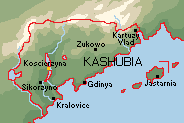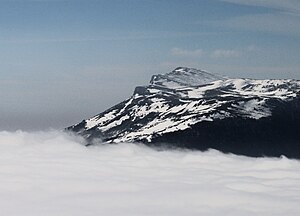Kashubia
This article is incomplete because it is pending further input from participants, or it is a work-in-progress by one author. Please comment on this article's talk page to share your input, comments and questions. Note: To contribute to this article, you may need to seek help from the author(s) of this page. |
Republic of Kaszuby Republika Kaszuby Республика Кашубия Kasuhbia | |
|---|---|
Motto: Síla, Svoboda, Solidarita "Strength, Freedom, Unity" | |
Anthem: To The Allegiant Ones | |
 Topographical relief map with major cities. | |
| Capital and largest city | Kralovice |
| Ethnic groups (1931) | Kashubian 67.7% Czech 10.6% |
| Demonym(s) | Kashubian |
| Government | Unitary parliamentary republic (1919–1930) Unitary presidential constitutional republic (1919–1931) |
| Antonin Jaskowski | |
| Sovereign State | |
• Independence | 1918 |
• Constitution | 1918 |
| Area | |
• Total Land | 265,171.42 km2 (102,383.26 sq mi)does not include inland lakes |
• Water (%) | 13.41% |
| Population | |
• 2020 census | 14,861,348 |
• Density | [convert: invalid number] |
| GDP (PPP) | 2020 estimate |
• Total | $408.465 billion |
• Per capita | $27,599 |
| Currency | Koruna (KOR) |
| Time zone | UTC-1 (Menghean Southwestern Time) |
| Date format | yyyy-mm-dd; CE(AD) |
| Driving side | right |
| Calling code | +25 |
Kaszubya (/Ka-shU-bya/ in English), also known as Kashubia is a sovereign nation in central-coastal Kylaris. It is bordered by Vedmed to the north; Amathia to the east; Tengaria to the south, and Yavorstrana to the west. Kashubia's capital and largest city, Kralovice, is situated on the eastern shores of Lake Mareaspero. Though possessing a unique language and culture, Kashubia was a part of the Empire of Tengaria until its fall following the Great War (Kylaris), after which Kashubia gained its independence. It has a population of 14.8 billion, and an economy centered around agriculture, manufacturing, and mining.
Eytomology
n/a
History
Early History
Settlement in the area called Kashubia for the last 1,000 years started by the end of the Glacial Stage, some 13,000 years ago. Archeological traces have been found of various cultures during the Stone and Bronze Age, Baltic peoples, Germanic peoples during the Iron Age and, in the Dark Ages, West Slavic tribes and Vikings. Starting in the 10th century, early Kashubian rulers united the region.
Kingdom of Kashubia
The basis for the development of a Kashubian state was laid by the XXX dynasty, which had been preeminent since the 10th century. The conversion of Duke Mieszko I to Christianity paved the way for Kashubia to become a member of the family of Orthodox kingdoms. In 1000, the Tengarian Empire officially recognized Kashubia as a sovereign duchy. In 1025, Duke Vaclav I the Brave was crowned King of Kashubia, marking the starting date for a Kashubian Kingdom, though for long years the Poles were ruled not by Kings but by Dukes.
The King ruled the country in his own responsibility but was expected to respect traditional customs of the people. The succession to the rule was not legally restricted by primogeniture. All sons of the King or Duke had the same rights of inheritance, and the one that in some way proved the strongest succeeded to the throne.
Fragmentation
Period of fragmentation
Duke Stefan III, who reigned from 1102 to 1138, tried to end the repeated struggles between various claimants by setting the government of Kashubia on a more formal footing. In the Testament of Stefan III, he divided his lands into five Duchies and distributed them among his sons, and promised the Burghers and landowning nobles of the regions special privliges. This document is widely considered to be the world's first constitution.
To ensure unity, he established the consultation agreement, which stated that the king would be elected from the sons of the King by the Estates of the realm (Clergy, burghers, and nobility, respectively). To this end, it was decided that the landing of royal sons would be done only during succession, and would give authority over a predetirmined split of the 'Korunapřistane', or "Crownlands."
While the senorial part almost always fell to that member of the Dynasty that happened to be senior, the other four Duchies were inherited in the usual way among the descendants of the King's sons. These provisions were soon broken, however, with the various Dukes trying to gain the position of High Duke for themselves. The provisions, meant to ensure unity fragmented the country even further and resulted in a decline of monarchical power.
As part of the Grand Principality
Kaszuby was a client-state of the Grand Principality of Tengaria.
Iconclast Wars
DEFENESTRATION GANG
Revolution and Independence
During the Great War, almost one hundred thousand Kashubians fought as part of the Kasuhbian Legion against the Empire. In a large part thanks to their efforts during the war, Kaszuby was able to break free of Imperial reign and establish itself as an independent state for the first time since its partition by the Kingdom of Vihoslavia and the Empire.
Kashubian Legion
Czechs! On Trains! In Siberia!
Republic of Kazubya
The Republic is Kaszubya's modern-day state.
Geography
Steppe
Mareaspero Coast
Black Mountains
The Black Mountains dominate Kaszuby's northern and western frontiers. The mountains, named for the slate and obsidian that dominate their slopes, are both naturally hazardous and resource rich. The primary range forms an arc throughout Central and southeastern Patrium. Roughly 1,500 km (932 mi) long, the range stretches from the XXX, to Kaszuby's eastern frontier, and down to the southern Patriumonic coast. The highest range within the Carpathians is known as the Tatra mountains in northern Kaszuby, where the highest peaks exceed 2,600 m (8,530 ft).
Zelenamoriya Foothills
Lake Sivash
Geology
Land use
Climate
Government
Constitution and Law
Administrative divisions
Politics
Foreign Relations
Military
Economy
Agriculture
Manufacturing
Mining
Energy
Culture
who gives a flying fuck



